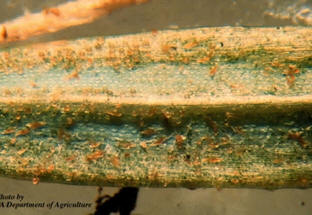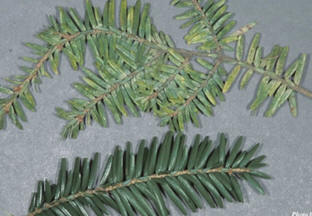Hemlock Rust Mite
 DESCRIPTION
DESCRIPTION
The Hemlock Rust Mite, as this pest is sometimes called, belongs to a group of microscopic mites referred to as eriophyids. The adult Hemlock Rust Mite is not visible to the naked eye. A 10-20X hand lens is needed to glimpse the mite, and much higher magnification is required to identify it to species. The orange to pink adult is about 0.25 mm long, wedgelike, and has a pair of long, anteriorly pointing setae located dorsally behind the second pair of legs.
LIFE CYCLE
This species of eriophyid is a cool weather pest. The overwintering eggs hatch in early to mid-March, before those of spruce spider mite. Poplulations of this mite build quickly in early spring, with most eggs hatching within the first week. In the Pennsylvania area, an average of 24 eggs/needle have been frequently observed. The popluations decrease in the summer and increase in the fall before overwintering eggs are deposited in November. Nymphs emerge from the egg headfirst and immediately move to healthy tissue to feed, probing the needle with their beak before inserting the chelicerae. The mite feeds on the upper surface of the needle for a short time and then moves to the undersurface; first generation eggs are deposited here, and subsequent generations are restricted to feeding on this surface.
 DAMAGE
DAMAGE
At first glance, damage caused by the Hemlock Rust Mite appears similar to that caused by spruce spider mite. The chlorotic spots are much smaller, however, and give the needle a silvery appearance that is especially evident along the outer margin of the needle. Premature needle drop will result if the population is left unchecked. In general, Hemlock Rust Mite can be identified by the damage and presence of cast skins on the underside of the needle. In winter, look for white to amber eggs along the base of the needle, where it lies flat against the stem.
CONTROL
Eriophyid mites are not susceptible to control with the standard miticides. Consult your Keystone certified arborist for materials suitable for control of these pests.
* See Woody Ornamental Insect, Mite and Disease Management, The Pennsylvania State University (2005) for more details.
WARNING: Pesticides are poisonous. Read and follow directions and safety precautions on labels. Handle carefully and store in original labeled containers out of reach of children, pets and livestock. Dispose of empty containers right away , in a safe manner and place. Do not contaminate forage, streams or ponds.
For professional assistance with tree and shrub problems contact a Keystone arborist.


